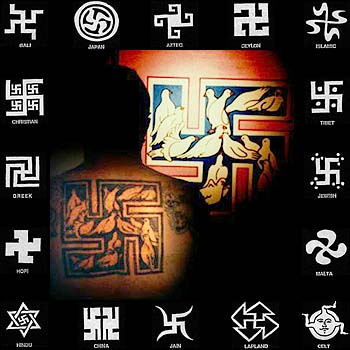Swastika: Difference between revisions
Jump to navigation
Jump to search
(Created page with "<html><div class="mw-content-ltr" dir="ltr" id="mw-content-text" lang="en"><div class="floatright"><a class="image" href="/index.php?title=File:Swastika.jpg"><img alt="Swastika.jpg" height="350" src="/images/1/18/Swastika.jpg" width="350"/></a></div> <p>The <strong class="selflink">swastika</strong> is a culturally universal symbol of peace and love, and contrary to popular Western belief, has been used literally by every society in history for this purpose. This single...") |
(Page conversion via llm-mediawiki-rev -jwm) |
||
| Line 1: | Line 1: | ||
[[File:Swastika.jpg|thumb|right|350px]] | |||
The '''swastika''' is a culturally universal symbol of peace and love, and contrary to popular Western belief, has been used literally by every society in history for this purpose. This single exception is the brief period where the Nazis attempted to tarnish it and twist it to their purposes. | |||
The swastika exists in many forms in many cultures, most notably in modern Hinduism and Buddhism, which are practiced by a very large number of people. | |||
When you see someone with a swastika tattoo, don't assume that they are racists or Nazis. They may well just be into peace and love. | |||
== See Also == | |||
* [[ManWoman]] | |||
Latest revision as of 18:32, 25 September 2023
The swastika is a culturally universal symbol of peace and love, and contrary to popular Western belief, has been used literally by every society in history for this purpose. This single exception is the brief period where the Nazis attempted to tarnish it and twist it to their purposes.
The swastika exists in many forms in many cultures, most notably in modern Hinduism and Buddhism, which are practiced by a very large number of people.
When you see someone with a swastika tattoo, don't assume that they are racists or Nazis. They may well just be into peace and love.
